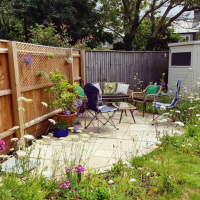This Forum will close on Wednesday 27 March, 2024. Please refer to the announcement on the Discussions page for further detail.
Mulching vegetable raised bed with bark?
 WildFlower_UK
Posts: 236
WildFlower_UK
Posts: 236
in Fruit & veg
I'm installing a smallish (approx 2x2m but L-shaped) raised bed this month, in which I hope to grow some vegetables. Weeds are a constant source of irritation in my garden, so along with trying to stop weed seeds from landing and growing in the patch, I also was thinking a bark mulch would be good for slowing down water evaporation as it will be in the sunniest part of the garden (summer sun hits it from 7-8am to 5pm).
I used some bark in large planters this summer which definitely helped with preventing weeds and keeping the soil moist, but was wondering whether it was common practice to use wood bark in larger areas?
I'll be growing thirsty plants in the raised bed; courgettes and dwarf French beans, and some beetroot and radishes in where space allows.
I used some bark in large planters this summer which definitely helped with preventing weeds and keeping the soil moist, but was wondering whether it was common practice to use wood bark in larger areas?
I'll be growing thirsty plants in the raised bed; courgettes and dwarf French beans, and some beetroot and radishes in where space allows.
"If you have a garden and a library, you have everything you need"
0
Posts
Using it for annual veggies will be problematic when you come to clear the bed at the end of the season for the next crops. We used grass cuttings as a mulch on our courgettes last summer and that worked well and then a quick hoeing proved effective for our other crops. Just make sure you plant your rows far enough apart to let a hoe move easily.
Sorry if I'm missing something here!
How hard can it be to a do a weekly hoeing of a 4 square metre raised bed?
Bark is fine for established shrubs, woody perennials etc. Even so, weed seeds seem to still manage to self-seed into it and birds love to toss it around. You can mulch between rows of veg with straw, which is less harmful (I do it with potatoes) but these coarser mulches shouldn’t be in direct contact with the base of the plants or rows of emerging direct-sown seeds like radishes. Tbh with that size bed, bark or straw is probably more trouble than it’s worth. A thick layer of compost used as a mulch would do the job, radish seeds will push through that no problem and easy to weed. Don’t mulch around the necks of courgettes tho, it can rot them.
Does this seem sensible?
It certainly does. Absolutely irritating. I've learned that lesson!